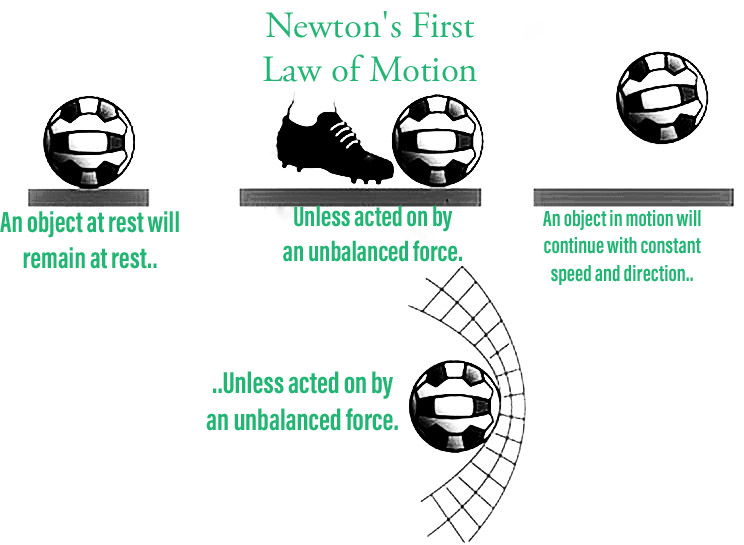质量和惯性
物理学领域发生了许多事件,但其中一些事件长期以来一直无法解释。牛顿提出了三个运动规则,这就是著名的牛顿运动定律。这些定律是物理宇宙中的一个新发现,它们经常被用来解释以前无法解释的情况。众所周知,牛顿三定律被用来建立我们周围物体的运动与作用于它们的自然或外力之间的关系。
推动或拉动物体,使其工作的物体加速,称为力。牛顿 (N) 是力的国际单位制单位。力可以通过三种方式影响身体。它具有改变物体速度、物体运动方向和物体形状的能力。力是一个向量,因为它既有大小又有方向。此外,力仅作为碰撞的结果而存在。
如果没有相互作用,物体将不再感受到力。同样,惯性与第一运动定律一起被用来描述物理现象。在我们了解什么是惯性之前,最好先回顾一下牛顿第一定律:
牛顿第一运动定律
根据牛顿第一定律,
Unless and until an external force acts on a body, it remains at rest or in uniform motion along a straight line.
简单来说,牛顿第一运动定律指出,除非外力作用于物体,否则物体不会开始运动。一旦它开始运动,它就不会停止或改变它的速度,除非并且直到另一个力作用在它上面。惯性定律是第一运动定律的别称。

大量的
It is one of the fundamental quantities in Physics and the most basic property of matter. We can define mass as the measure of the amount of matter in a body.
物体的质量不会随着时间而改变。仅在特殊情况下,例如从身体提供或获取大量能量时。质量是一个标量,因为它只有大小。
千克 (kg)是 SI 质量单位。
例如,核反应将少量物质转化为大量能量,从而减少物质的质量。
惯性
伽利略·伽利莱创造了“惰性”一词。据称,惯性是物体抵抗静止或匀速运动状态变化的趋势。惯性是物体的质量,允许它们保持静止,或者如果移动,则继续沿直线行进。
惯性和质量相互依赖。质量与其惯性成正比,物体的质量越大,惯性越大,因此改变其运动状态所需的力也越大。
学习惯性的一些例子是:
- 板球的惯性比橡皮球大,改变方向需要很大的力。
- 石头比足球有更大的惯性,这就是为什么它不能轻易被踢到空中。
惯性类型
惯性分为三种:
- 静止惯性:物体或物体不能自行改变静止状态称为静止惯性。例如,当汽车突然启动时,车内的乘客会向后倒
- 运动惯性:物体或物体无法自行改变其运动状态称为运动惯性。例如,在一辆行驶中的汽车中,当它突然停下来时,所有的乘客都会向前摔倒。
- 方向惯性:任何物理物体不能自行改变其运动方向的能力称为方向惯性。例如,当汽车沿圆形曲线行驶时,坐在里面的乘客会被向外抛。
让我们进行一项活动来了解更多关于惯性的信息,
- 如图所示,在玻璃杯口放一张厚方形卡片。然后将一枚硬币放在这张牌的中间。

- 起初,卡片和硬币处于静止状态。当我们用手指敲击卡片时,会有一种力作用在卡片上,使其从静止状态变为运动状态。
- 结果,卡片离开了玻璃杯的嘴。另一方面,我们轻弹的力量对硬币没有影响,因此它由于惯性而处于静止状态。
- 由于惯性,当放置它的卡片移开时,便士落入玻璃杯中。
现实生活中遇到惯性的例子有:
- 我们在乘公共汽车或其他车辆旅行时向前跌倒,然后突然停止。
Because the lower half of our body is in contact with the ground, any forces operating on the bus’s base will be sensed by our lower half, which will react correspondingly. The upper half of our bodies, on the other hand, is not in contact with any portion of the vehicle. As a result, as the bus comes to a halt, the lower half of the body comes to a halt while the upper half continues to move, causing us to fall forward. We also tumble backwards when the bus suddenly starts.
- 头枕安装在汽车座椅中人的脖子后面,以保护他们免受严重的头部伤害。
This can occur as a result of rear-end collisions. When our vehicle gets hit from behind, we immediately tumble forward and come to a halt owing to the force of the impact. We soon fall forwards and backwards as a result of this. This happens in a matter of seconds and can result in serious head trauma. As a result, head restraints are used to offer cushion support.
示例问题
问题 1:如果牛顿第一定律成立,为什么在地面上滚动的球会自行停止?
解决方案:
When a ball is rolling on the ground, it will come to a halt due to an uneven external force (friction, gravity, etc.) acting on the ball. “Unless and until an external force acts on a body, it remains at rest or in uniform motion along a straight line,” says the first law of motion. Friction acts as an external force in this scenario, causing the ball to stop on its own.
问题 2:用例子定义惯性。
解决方案:
Inertia is a body’s tendency to resist a change in its condition of rest or uniform motion. Inertia is the quality of objects that allows them to remain at rest or, if moving, to continue traveling in a straight line.
Following are the examples:
- When a car is suddenly started, the passengers in it fall backward
- In a moving car, when it suddenly stops, all the passengers fall forward.
- When a car moves along a round curve, the passengers sitting inside are thrown outwards.
问题3:为什么我们用棍子敲打地毯时灰尘颗粒会飞出?
解决方案:
It’s all due to inertia of rest. When you beat a carpet with a stick, the carpet begins to move, but the dust particles remain in their state of rest. The dust particles fall out of the carpet as a result of the repeated beating, leaving you with a clean carpet.
问题4:影响惯性的因素有哪些?
解决方案:
Inertia depends on mass of an object and force as:
Inertia and mass depends directly on each other. Hence, more the mass of a body more will be its inertia and more will be the force required to change its state which means inertia and force also depends on directly.
Following are the examples:
- A cricket ball has higher inertia than a rubber ball, it takes a great deal of force to change its direction.
- A stone has more inertia than a football that is why it cannot be kicked into air easily.
问题5:为什么建议使用绳索将行李固定在公共汽车车顶上?
解决方案:
The motion of a moving vehicle, such as a bus, is not uniform; the vehicle’s speed varies, and it may hit the brakes quickly or make a sharp turn. Due to inertia, the luggage will oppose any change in its state of rest, motion, or direction, and it will tend to fall sideways, forward, or backward. The luggage is secured with a rope to prevent it from falling.